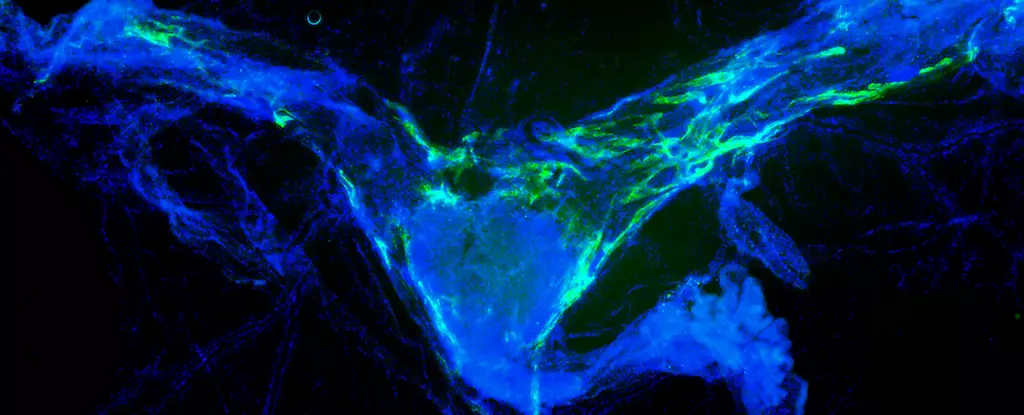As we progress through life, an unsettling reality emerges: our brain’s essential cleaning mechanisms begin to falter. This gradual degradation sparks a myriad of memory-related issues, ultimately leading to conditions like Alzheimer’s disease and other neurodegenerative disorders. While the situation seems dire, scientists have recently cut through the noise, unveiling promising research from a team at Washington University in St. Louis. Their innovative findings delve deep into the brain’s waste management system, particularly focusing on meningeal lymphatics. These vessels act as the diligent custodians of our cognitive faculties, and their malfunction may symbolize a growing crisis as we age.
Optimizing the Brain’s Waste Management System
The study’s researchers employed a targeted protein treatment on older mice, effectively reviving the waning meningeal lymphatics and encouraging them to operate at peak performance. The results were astounding: treated mice exhibited marked improvements in memory compared to their untreated counterparts. This breakthrough not only highlights the importance of these vessels but also raises an essential question about our approach to tackling memory loss—could revitalizing the brain’s waste clearance processes provide a direct line of defense against cognitive decline?
Kyungdeok Kim, a prominent neuroscientist at Washington University, aptly noted, “A functioning lymphatic system is critical for brain health and memory.” With mounting evidence suggesting that therapeutic approaches aimed at boosting waste management may benefit aging brains, we are presented with a glimmer of hope in an otherwise bleak narrative about memory loss.
The Role of Interleukin 6: A Dual-Edged Sword
In their investigation, the researchers identified interleukin 6, a protein that acts as a distress signal emitted by overwhelmed immune cells known as microglia. When the brain’s cleaning mechanisms falter, interleukin 6 levels spike, indicating chronic stress. Yet, the intervention not only ameliorated the mice’s memory but also correspondingly lowered interleukin 6 levels. This dual impact effectively restored balance in the immune environment, mitigating damage caused by distressed microglia.
The implications of this discovery could transcend current medical paradigms. In an era dominated by rapid biomedical advancements, managing the interplay between inflammation and memory health could redefine our approach to neurodegenerative diseases. Is tackling inflammation alongside enhancing lymphatic function the solution we’ve been seeking to combat dementia’s escalation?
Bypassing the Blood-Brain Barrier: A Breakthrough in Treatment
One of the most significant attributes of the study is the targeting of meningeal lymphatic vessels that lie just outside the brain. Unlike previous efforts that had to contend with the formidable blood-brain barrier, this avenue offers a simpler yet effective strategy for treatment. Jonathan Kipnis, also a neuroscientist at Washington University, emphasized this transition by stating, “By targeting a network of vessels outside of the brain that is critical for brain health, we see cognitive improvements in mice.”
This remarkable shift in treatment strategy signals a transformative moment in neurological research. The cognitive benefits observed challenge the traditional viewpoint that interventions must penetrate deep within the brain, leading us to reconsider how we design therapies for various neurological disorders. In essence, simplicity here may serve as a powerful ally in our battle against cognitive decline.
The Bigger Picture: Memory as a Collective Responsibility?
As we absorb these findings, the urgency to rethink how we treat cognitive decline becomes palpable. If our brains are akin to intricate railways, with meningeal lymphatics acting as the necessary maintenance crews, society must recognize our collective responsibility in safeguarding brain health as we age. The waste management metaphor becomes even clearer when one considers the social implications of memory loss; cognitive decline touches countless lives, affecting not just those who suffer but families, caregivers, and entire communities.
The intersection of science, policy, and public health must now pivot to incorporate these insights into a robust framework for aging populations. As research propels us toward new therapeutic avenues, the pressing need for advocacy and systemic support in cognitive health continues to grow. The question looms: are we prepared to embrace and act upon this newfound intelligence, or will we allow memory loss to creep forward unchecked like an unwanted intruder in our lives?
In a world grappling with rapid aging, the innovative work emerging from Washington University offers more than just hope; it propels a narrative that instigates proactive measures to ensure that our memories remain steadfast against the tides of time.

